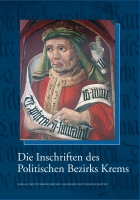Search
Gesammelt und bearbeitet von Andreas Zajic
Die Inschriften des Bundeslandes Niederösterreich
Teil 3: Die Inschriften des Politischen Bezirks Krems
2008
19.0 x 27.0 cm, 672 p., 71 illustrations b/w, 71 s/w-Tafeln, hard cover with dust jacket
19.0 x 27.0 cm, 672 p., 71 illustrations b/w, 71 s/w-Tafeln, hard cover with dust jacket
79,00 €
Short Description
The medieval and early modern epigraphic sources in the district of Krems (Lower Austria) offer an interesting glimpseinto the development of a very important arena of Austrian as well as European history, namely the Wachau, the
stretch of the Danube between Melk and Krems, which has been designated an UNESCO World Heritage site, the
Wachau Cultural Landscape. The inscriptions reflect the self-representation of the local nobility, the savoir-vivre of the
wealthy citizens of urban centres and marketplaces, as well as the influence of foreign landowners such as the Bavarian
monasteries or the archbishopric of St. Peter in Salzburg that held vast shares of the region's vineyards from the early
Middle Ages through the 19th century. These 528 inscriptions from before 1650 have been collected and edited for this
annotated publication according to the guidelines of the "Deutschen Inschriften" project. The publication presents new
details that contribute not only to the region's history, but also to general social and cultural history as well as the history of
confessions and mentalities.
Description
No english description available. Showing german descriptionInschriften, überwiegend im öffentlichen Raum angebracht, stellen ein spezifisches Medium von Schriftlichkeit dar, bei
dessen Interpretation möglichst interdisziplinär formulierte Fragen nach Auftraggeber, Funktion, Sprache, Text- und
Schriftgestaltung sowie Material und Technik besondere Bedeutung haben. Die mittelalterlichen und frühneuzeitlichen Inschriften des Politischen Bezirks Krems (Niederösterreich) bis zum Jahr 1650 bieten einen aufschlussreichen Blick in die historische Entwicklung eines Kernraums österreichischer und mitteleuropäischer Geschichte, der mit dem Donauabschnitt zwischen Melk und Krems u. a. das UNESCO-Weltkulturerbe Wachau umfasst. In den inschriftlichen Quellen – Grab- und
Bauinschriften, Stifter- und Gedenkinschriften, erklärende Beischriften zu Wandmalereien und Gemälden u. v. m. – spiegeln sich Repräsentation und Streben nach Memoria des landständischen Adels ebenso wie des wohlhabenden Bürgertums der landesfürstlichen Städte und Märkte, die als regionale und überregionale Handelsplätze Bedeutung besaßen. Die Rolle landfremder Grundherren für die kulturelle und wirtschaftliche Entwicklung der Region manifestiert sich in jenen Inschriften, die auf die zahlreichen bayerischen Klöster mit Weingartenbesitz an der Donau bzw. das Erzstift Salzburg verweisen. Die 528 Katalognummern wurden für eine Edition nach den Richtlinien des von den Deutschen Akademien der Wissenschaften und der Österreichischen Akademie der Wissenschaften gemeinsam erarbeiteten Corpus-Werks „Die Deutschen Inschriften“ gesammelt, bearbeitet und ausführlich kommentiert. Eine ausführliche Einleitung, ein umfangreicher Abbildungsteil und zahlreiche Register ergänzen und erschließen die Publikation.






 Neuerscheinungen 2023/2024
Neuerscheinungen 2023/2024
 Gesamtverzeichnis 2023/2024
Gesamtverzeichnis 2023/2024
 Katalog Oriental Studies & Linguistics
Katalog Oriental Studies & Linguistics
 Mittelalter
Mittelalter
 Deutsche Inschriften
Deutsche Inschriften
 Musiktherapie
Musiktherapie
 Literaturen im Kontext
Literaturen im Kontext